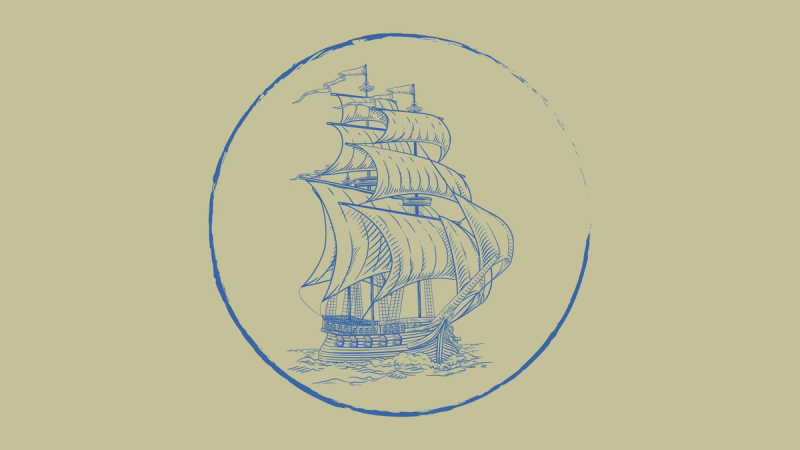Ships that fail to reach their destination cause trouble. For six days in March 2021, the container ship Ever Given—more “sideways skyscraper than boat”—got stuck in the Suez Canal, scotched the global movement of goods, and froze nearly $10 billion in trade daily. We know this lesson well, not least because we all saw the memes. But sometimes ships that reach port successfully also cause trouble. Throughout the early modern period, Dutch Reformed missionaries in Brazil learned that lesson well, because they experienced it not through memes but up close and first hand. And repeatedly.
It was 1636, and Jodocus van Stetten could have pulled his hair out. Originally from the German-Polish borderlands near the Baltic Sea, Stetten was a minister in the Dutch Reformed Church who labored with the Reformed mission in northwest Brazil. After years of fighting the Portuguese for land and sugar in Brazil, the Dutch Republic had, through the powerful trading arm of the Dutch West India Company (WIC), set up in the region a large colony known as “Little Holland,” which lasted formally from 1630 to 1654. More than once, Stetten watched trading ships arrive and sailors unload their cargo, piling up highly anticipated barrels crammed with books in busy dockyard warehouses. In the spring of 1636, the board of the WIC sent him John Calvin’s Institutes of the Christian Religion in Dutch and the Acts of the Synod of Dort (1618–1619) in Latin. For missionaries who usually had to make do with little, the scene pleased greatly. Only one fly disturbed the ointment—but it was large and buzzed loudly. The latest books, intended specifically for use in schools and churches, arrived in Spanish, not Portuguese!
Stetten responded by asking the WIC directors to load the next ship bound for Recife, the colonial capital, with more books. In gentle terms, he explained to his superiors that few Brazilians used “Castilian” (that is, Spanish). He had been learning to speak Portuguese himself, but good theology books remained hard to obtain. The greatest need, he wrote, was twofold: a Portuguese Bible, like the kind currently being printed in Lisbon, and copies of the Heidelberg Catechism. The letter concluded with words he must have hoped would remove all doubt: “I am speaking of Portuguese, not Castilian, as you gentlemen had the other [catechisms] translated, all of which are useless here.” Still, language debacles continued to occur.
During the height of the Dutch Golden Age, which ran roughly from 1588 to 1672, global missions took on remarkable significance. The WIC played an outsized role in the Atlantic world. So too did its geographical counterpart, the Dutch East India Company (VOC) in the Asian world. The relationship between evangelism and empire was complex. The WIC and VOC sponsored ministers to provide spiritual oversight to employees and their families. The trading companies had interests in commerce and empire building at heart. Some of their personnel left trails of coercion, predation, enslavement, and entangling efforts to convert pagans, Moors, Jews, and Catholics. But others displayed unusual understanding and respect. Even so, notes Charles Parker, the “Dutch ministers traveling into overseas territories were first and foremost pastors.”
The leading Dutch universities of Leiden and Utrecht (intellectual powerhouses of both learning generally and Reformed theology particularly) devoted substantial resources to getting the gospel right and getting the gospel out. In 1622 to 1623, Antonius Walaeus, a theologian at Leiden, opened a seminary to train ministers for overseas service with aid from the VOC. In 1634, Gisbertus Voetius joined the faculty at Utrecht and took a leading academic role in supporting the global spread of Calvinism. A delegate at the Synod of Dort, Voetius called on his fellow members there to formally declare their commitment to “the propagation of the gospel in the East Indies and other places.” Voetius had read early missionary stories from Southeast Asia and Brazil. Mindful of the Ottoman Empire on Europe’s eastern frontier, he learned Arabic and began to lecture on Islam and paganism. He conferred with overseas ministers about beneficial strategies to spread the gospel and plant churches, all while consistently opposing slavery. Other Calvinist theologians and intellectuals—including Johannes Hoornbeeck, Johannes Cocceius, Georgius Hornius, and Adriaan Reland—also equipped their students for service in overseas assignments.
Ships sent out by the WIC and VOC became floating industries, villages, churches, families. Like an early modern Noah’s ark, each ship was crowded with up to two hundred crew, myriad goods and supplies, and an indeterminate number of passengers. They carried sailors and merchants and cargo, of course, but also ordained ministers and nonordained “comforters of the sick”—some to stay with the vessel, some to travel onwards. Even as they sailed, those on board continued to gather to worship God and to keep the Lord’s Day as best as they could. And as we’ve seen, the ships carried books. In fact, far more than either foreign or domestic products—imported sugar, paintings by Rembrandt or Vermeer—books captured the public imagination and came to represent the marvel that was the Dutch Republic.
The most popular book to travel the hemispheres was the “States Bible” (Statenvertaling) of 1637, the first translation of the Bible into Dutch directly from the original languages, which had been commissioned by the Synod of Dort and financed by the government. Trade company directors quickly ordered batches of new Bibles to use onboard and to deliver to overseas missionaries. Just as quickly, they received complaints that the text was too small to read from pulpits. So, the frugal Dutch traders reluctantly purchased larger, more expensive, folio editions. They also furnished every ship with enough copies to go around of a psalter for sailors and a catechism—usually the Heidelberg, often in a multilingual edition. On a typical VOC ship, less than half of the crew could realistically expect to ever see home again. The Bible, the psalter, and the catechism would be their regular, and final, consolation. Comforters of the sick likewise had a checklist of typical titles they were given before they traveled to the Americas. The list included the Bible in Dutch and Spanish, Calvin’s Institutes in Dutch, an introduction to the Heidelberg Catechism in Dutch, Heinrich Bullinger’s Decades (a collection of fifty sermons in five books) in Dutch, Theodore Beza’s Complete Summary of Christianity in Dutch, William Perkins’ Reformed Catholic in Dutch, and William Bucanus’s Commonplaces in Dutch. The ships themselves would become naval lending libraries. When Dutch missionaries in various forts and colonies complained about the lack of books in local outposts, trade company directors told them to visit the harbor, board the vessels, and borrow what they needed.
From my perspective, this is one of the most fascinating scenes from the early modern period. Picture it: Dutch ships with anchors weighed, somewhere in the middle of the ocean. For a few odd moments each Lord’s Day, ministers and parishioners aboard—whatever else they might be doing as part of Dutch empire building—laid all else aside to express the global communion of saints and the catholicity of the faith. The same ecumenical creeds confessed on one side of the globe echoing on the other, the same psalms sung as praise to God on one continent finding antiphonal response on another.
Footnotes
https://www.nytimes.com/2021/07/17/world/middleeast/suez-canal-stuck-ship-ever-given.html; https://fortune.com/2021/03/25/ever-given-suez-ship-stuck-internet-memes/.
BackMichiel van Groesen, Imagining the Americas in Print: Books, Maps, and Encounters in the Atlantic World (Leiden: Brill, 2019), 169.
BackD. L. Noorlander, “The Reformed Church and the Regulation of Religious Literature in the Early Dutch Atlantic World,” Itineratio 42, no. 3 (2018): 375–402.
BackJodocus â Stetten to Chamber Zeeland, 16 July 1636, cited in Michiel van Groesen, Imagining the Americas in Print: Books, Maps, and Encounters in the Atlantic World (Leiden: Brill, 2019), 172: “Ic sprecke van Portuges, niet Castiliaens gelic u E.E. de anderen hebt late translateren, de welcke alle sonder profit alhier seijn.”
BackNoorlander, “The Reformed Church,” 383.
BackCharles H. Parker, Global Calvinism: Conversion and Commerce in the Dutch Empire, 1600–1800 (New Haven: Yale University Press, 2022), 6.
BackSee, e.g., D. L. Noorlander, Heaven’s Wrath: The Protestant Reformation and the Dutch West India Company in the Atlantic World (Ithaca, NY: Cornell University Press, 2019); Jonathan Israel and Stuart B. Schwartz, The Expansion of Tolerance: Religion in Dutch Brazil (1624–1654) (Amsterdam: Amsterdam University Press, 2007); Benjamin Schmidt, Innocence Abroad: The Dutch Imagination and the New World, 1570–1670 (Cambridge: Cambridge University Press, 2001); and Frans Schalkwijk, The Reformed Church in Dutch Brazil, 1630–1654 (Zoetermeer: Boekencentrum, 1998).
BackParker, Global Calvinism, 127.
BackAccording to H. A. van Andel, the synod ratified Voetius’s resolution, though the resolution never appeared in the official version of the act. Van Andel, De zendingsleer van Gisbertus Voetius (Kampen: J. H. Kok, 1912), 16. On “missions” here, see W. J. van Asselt, Voetius (Kampen: De Groot Goudriaan, 2007); Jan A. B. Jongeneel, “Voetius’ zendingstheologie, de eerste comprehensieve Protestantse zendingstheologie,” in De onbekende Voetius: voordrachten wetenschappelijk symposium Utrecht 3 maart 1989, ed. J. van Oort (Kampen: Kok, 1989), 117–47.
BackParker, Global Calvinism, 31, 107, 201, 236–73.
BackFor a masterful survey, see Andrew Pettegree and Arthur van Weduwen, The Bookshop of the World: Making and Trading Books in the Dutch Golden Age (New Haven: Yale University Press, 2020).
BackSee, e.g., Willem Frijhoff, Fulfilling God’s Mission: The Two Worlds of Dominie Everardus Bogardus (Leiden: Brill, 2007), 324–25.
BackNoorlander, “The Reformed Church,” 379.
Back






